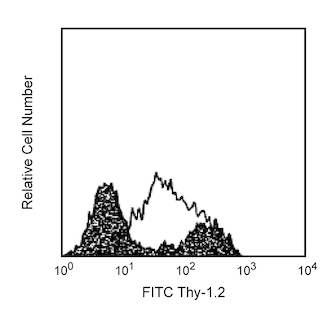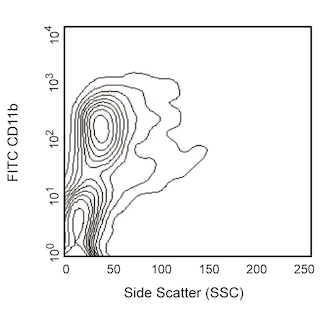Old Browser
This page has been recently translated and is available in French now.
Looks like you're visiting us from {countryName}.
Would you like to stay on the current country site or be switched to your country?


.png)

Flow cytometric analysis of CD135 on mouse bone marrow cells. Bone marow cells from BALB/c mice were stained with FITC Rat Anti-Mouse CD11b (Cat. No. 553310) and FITC Rat Anti-Mouse CD45R/B220 (Cat. No. 553088) in conjunction with either a APC Rat IgG2a, κ isotype control (left panel) or with the APC Rat Anti-Mouse CD135 antibody (right panel). Dot plots were derived from gated events based on light scattering characteristics for bone marrow cells. Flow cytometry was performed on a BD™ LSR II flow cytometry system.
.png)

BD Pharmingen™ APC Rat Anti-Mouse CD135
.png)
Regulatory Status Legend
Any use of products other than the permitted use without the express written authorization of Becton, Dickinson and Company is strictly prohibited.
Preparation And Storage
Product Notices
- Since applications vary, each investigator should titrate the reagent to obtain optimal results.
- An isotype control should be used at the same concentration as the antibody of interest.
- This APC-conjugated reagent can be used in any flow cytometer equipped with a dye, HeNe, or red diode laser.
- Caution: Sodium azide yields highly toxic hydrazoic acid under acidic conditions. Dilute azide compounds in running water before discarding to avoid accumulation of potentially explosive deposits in plumbing.
- For fluorochrome spectra and suitable instrument settings, please refer to our Multicolor Flow Cytometry web page at www.bdbiosciences.com/colors.
- Please refer to www.bdbiosciences.com/us/s/resources for technical protocols.
Companion Products

.png?imwidth=320)


The A2F10 monoclonal antibody specifically binds to Flk-2/Flt3 (Ly-72, CD135), a receptor protein tyrosine kinase closely related to c-kit, c-fms, and PDGF Receptor of the immunoglobulin superfamily. The Flt3 message is detected in hematopoietic stem cells and primitive progenitor cells in fetal liver, adult bone marrow, and fetal and adult thymus, as well as brain, placenta, and testis; but it is absent in more mature hematopoietic cells. In flow cytometric analysis, the A2F10 antibody recognizes Flt3-transfected Y3 cells (rat myeloma), but not the parent cell line in addition to recognizing early B lymphoid lineage cells in juvenile and adult bone marrow. A role for CD135 in the regulation of hematopoiesis is suggested by the observations that soluble Flk-2/Flt3 ligand can both stimulate proliferation of stem cell-enriched fetal liver, fetal thymus, and adult bone marrow populations and enhance their responses to other growth factors in vitro. In addition, injection of Flk-2/Flt3 ligand stimulates extramedullary hematopoiesis in the mouse spleen and accumulation of dendritic cells in the hematopoietic system. mAb A2F10.1 is reported to immunoprecipitate a 150-kDa surface protein from the murine myeloblast cell line M1, which naturally expresses CD135, and to inhibit the binding of Flk-2/Flt3 ligand to CD135.

Development References (10)
-
Hannum C, Culpepper J, Campbell D, et al. Ligand for FLT3/FLK2 receptor tyrosine kinase regulates growth of haematopoietic stem cells and is encoded by variant RNAs. Nature. 1994; 368(2):643-648. (Biology). View Reference
-
Lyman SD, James L, Vanden Bos T, et al. Molecular cloning of a ligand for the flt3/flk-2 tyrosine kinase receptor: a proliferative factor for primitive hematopoietic cells. Cell. 1993; 75(6):1157-1167. (Biology). View Reference
-
Matthews W, Jordan CT, Wiegand GW, Pardoll D, Lemischka IR. A receptor tyrosine kinase specific to hematopoietic stem and progenitor cell-enriched populations. Cell. 1991; 65(7):1143-1152. (Biology). View Reference
-
Ogawa M, Sugawara S, Kunisada T, et al. Flt3/Flk-2 and c-Kit are not essential for the proliferation of B lymphoid progenitor cells in the bone marrow of the adult mouse. Exp Hematol. 1998; 26(6):478-488. (Immunogen). View Reference
-
Ogawa M, ten Boekel E, Melchers F. Identification of CD19(-)B220(+)c-Kit(+)Flt3/Flk-2(+)cells as early B lymphoid precursors before pre-B-I cells in juvenile mouse bone marrow. Int Immunol. 2000; 12(3):313-324. (Biology). View Reference
-
Orlic D, Fischer R, Nishikawa S, Nienhuis AW, Bodine D. Purification and characterization of heterogeneous pluripotent hematopoietic stem cell populations expressing high levels of c-kit receptor. Blood. 1993; 82(3):762-770. (Biology). View Reference
-
Shurin MR, Pandharipande PP, Zorina TD, et al. FLT3 ligand induces the generation of functionally active dendritic cells in mice. Cell Immunol. 1997; 179(2):174-184. (Biology). View Reference
-
Veiby OP, Jacobsen FW, Cui L, Lyman SD, Jacobsen SE. The flt3 ligand promotes the survival of primitive hemopoietic progenitor cells with myeloid as well as B lymphoid potential. Suppression of apoptosis and counteraction by TNF-alpha and TGF-beta. J Immunol. 1996; 157(7):2953-2960. (Biology). View Reference
-
Veiby OP, Lyman SD, Jacobsen SE. Combined signaling through interleukin-7 receptors and flt3 but not c-kit potently and selectively promotes B-cell commitment and differentiation from uncommitted murine bone marrow progenitor cells.. Blood. 1996; 88(4):1256-65. (Biology). View Reference
-
Wasserman R, Li YS, Hardy RR. Differential expression of the blk and ret tyrosine kinases during B lineage development is dependent on Ig rearrangement. J Immunol. 1995; 155(2):644-651. (Biology). View Reference
Please refer to Support Documents for Quality Certificates
Global - Refer to manufacturer's instructions for use and related User Manuals and Technical data sheets before using this products as described
Comparisons, where applicable, are made against older BD Technology, manual methods or are general performance claims. Comparisons are not made against non-BD technologies, unless otherwise noted.
For Research Use Only. Not for use in diagnostic or therapeutic procedures.
Report a Site Issue
This form is intended to help us improve our website experience. For other support, please visit our Contact Us page.